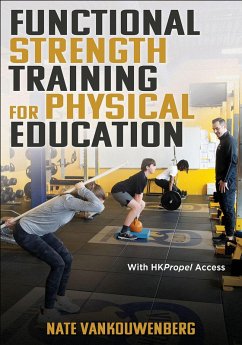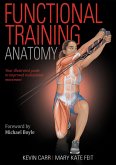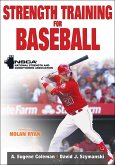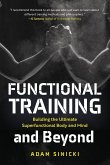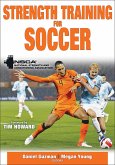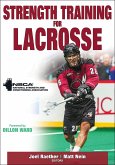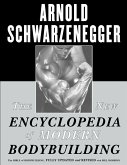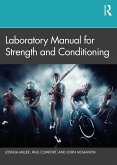Nate VanKouwenberg
Functional Strength Training for Physical Education
Nate VanKouwenberg
Functional Strength Training for Physical Education
- Broschiertes Buch
- Merkliste
- Auf die Merkliste
- Bewerten Bewerten
- Teilen
- Produkt teilen
- Produkterinnerung
- Produkterinnerung
Functional Strength Training for Physical Education is an easy-to-follow guide for PE teachers and coaches working with middle and high school students. It outlines the benefits of functional strength training and how to develop a program that will give all students skills for their lifetime.
Andere Kunden interessierten sich auch für
![Functional Training Anatomy Functional Training Anatomy]() Kevin CarrFunctional Training Anatomy33,99 €
Kevin CarrFunctional Training Anatomy33,99 €![Strength Training for Baseball Strength Training for Baseball]() Strength Training for Baseball38,99 €
Strength Training for Baseball38,99 €![Functional Training and Beyond Functional Training and Beyond]() Adam SinickiFunctional Training and Beyond22,99 €
Adam SinickiFunctional Training and Beyond22,99 €![Strength Training for Soccer Strength Training for Soccer]() Strength Training for Soccer38,99 €
Strength Training for Soccer38,99 €![Strength Training for Lacrosse Strength Training for Lacrosse]() Strength Training for Lacrosse30,99 €
Strength Training for Lacrosse30,99 €![The New Encyclopedia of Modern Bodybuilding The New Encyclopedia of Modern Bodybuilding]() Arnold SchwarzeneggerThe New Encyclopedia of Modern Bodybuilding33,99 €
Arnold SchwarzeneggerThe New Encyclopedia of Modern Bodybuilding33,99 €![Laboratory Manual for Strength and Conditioning Laboratory Manual for Strength and Conditioning]() Joshua MillerLaboratory Manual for Strength and Conditioning69,99 €
Joshua MillerLaboratory Manual for Strength and Conditioning69,99 €-
-
-
Functional Strength Training for Physical Education is an easy-to-follow guide for PE teachers and coaches working with middle and high school students. It outlines the benefits of functional strength training and how to develop a program that will give all students skills for their lifetime.
Hinweis: Dieser Artikel kann nur an eine deutsche Lieferadresse ausgeliefert werden.
Hinweis: Dieser Artikel kann nur an eine deutsche Lieferadresse ausgeliefert werden.
Produktdetails
- Produktdetails
- Verlag: Human Kinetics Publishers
- Seitenzahl: 160
- Erscheinungstermin: 18. April 2024
- Englisch
- Abmessung: 253mm x 175mm x 10mm
- Gewicht: 406g
- ISBN-13: 9781718215818
- ISBN-10: 1718215819
- Artikelnr.: 69484573
- Herstellerkennzeichnung
- Libri GmbH
- Europaallee 1
- 36244 Bad Hersfeld
- gpsr@libri.de
- Verlag: Human Kinetics Publishers
- Seitenzahl: 160
- Erscheinungstermin: 18. April 2024
- Englisch
- Abmessung: 253mm x 175mm x 10mm
- Gewicht: 406g
- ISBN-13: 9781718215818
- ISBN-10: 1718215819
- Artikelnr.: 69484573
- Herstellerkennzeichnung
- Libri GmbH
- Europaallee 1
- 36244 Bad Hersfeld
- gpsr@libri.de
Nate VanKouwenberg, CFSC, is a physical education teacher and strength and conditioning coordinator in the Victor Central School District in New York. Using his experience developing Victor’s K-12 functional strength training curriculum, VanKouwenberg has created a comprehensive professional development workshop for teachers, coaches, athletic directors, and college students called Functional Strength Training for PE. He has presented at countless conferences and school districts over the years to improve the quality of physical education fitness units and high school strength and conditioning programs. In addition, VanKouwenberg is the founder and owner of Next Level Strength and Conditioning in Rochester, New York. Since 2004, Next Level has helped a wide range of athletes and general fitness enthusiasts reach their goals. Aside from his role on the business and staff development side of Next Level, he also coaches their Pro Total Hockey Training group each summer. He served as the strength and conditioning coach for the Rochester Institute of Technology (RIT) Division I men’s hockey team for eight seasons.
Part I. Foundations of Functional Strength Training
Chapter 1. Strength Training for All
What Is Strength?
Strength Training Options
What’s Next
Chapter 2. Why Functional Strength Training?
Benefits of Functional Strength Training
What’s Next
Chapter 3. Functional Strength Training 101
Functional Joint-by-Joint Approach
Functional Movement Patterns Versus Muscle Groups
Planes of Motion
Unilateral Versus Bilateral Exercises
Debunking Common Strength Training Myths
What’s Next
Chapter 4. Functional Strength Training Progressions and Regressions
Implementing Skill Progressions and Regressions
Example Skill Variations
What’s Next
Part II. Functional Strength Training for Physical Education
Chapter 5. Why Functional Strength Training in Physical Education?
Benefits of Functional Strength Training in Physical Education
Challenges of Implementing Functional Strength Training in Physical
Education
Tips for Implementing Functional Strength Training
What’s Next
Chapter 6. Curriculum Design
The Victor Way
Applying Skill Progressions to a Sequential K-12 Curriculum Map
Secondary PE Functional Strength Training Curriculum Outline
Using a Curriculum Map to Build a Unit Plan
FUNdamentals of Functional Strength Training in Elementary Physical
Education
Connecting Functional Strength Training to National Standards
What’s Next
Chapter 7. Teaching Considerations
Class Management Strategies
Lesson Sequencing
Safety Considerations
Functional Strength Training and the Affective Domain
Modifications for Students With Disabilities
What’s Next
Chapter 8. Assessment
Why Assess?
Assessment Types
Cognitive Assessment
Using Assessments to Calculate Physical Education Grades
What’s Next
Part III. Functional Strength Training in Action
Chapter 9. Facility Design
Spatial Considerations
Equipment Considerations
Facility Flow
What’s Next
Chapter 10. Program Design
Exercise Selection
Volume
Intensity
Individualized Modifications Based on Personal Goals and Ability Level
What’s Next
Chapter 11. Connecting Functional Strength Training in Physical Education
to Athletics
Goals of a Quality High School Strength and Conditioning Program
Extracurricular Sport Performance Program Design Guidelines
Strength and Conditioning Certification Recommendations
Closing Remarks
Appendix: Functional Strength Training for PE Resources
Chapter 1. Strength Training for All
What Is Strength?
Strength Training Options
What’s Next
Chapter 2. Why Functional Strength Training?
Benefits of Functional Strength Training
What’s Next
Chapter 3. Functional Strength Training 101
Functional Joint-by-Joint Approach
Functional Movement Patterns Versus Muscle Groups
Planes of Motion
Unilateral Versus Bilateral Exercises
Debunking Common Strength Training Myths
What’s Next
Chapter 4. Functional Strength Training Progressions and Regressions
Implementing Skill Progressions and Regressions
Example Skill Variations
What’s Next
Part II. Functional Strength Training for Physical Education
Chapter 5. Why Functional Strength Training in Physical Education?
Benefits of Functional Strength Training in Physical Education
Challenges of Implementing Functional Strength Training in Physical
Education
Tips for Implementing Functional Strength Training
What’s Next
Chapter 6. Curriculum Design
The Victor Way
Applying Skill Progressions to a Sequential K-12 Curriculum Map
Secondary PE Functional Strength Training Curriculum Outline
Using a Curriculum Map to Build a Unit Plan
FUNdamentals of Functional Strength Training in Elementary Physical
Education
Connecting Functional Strength Training to National Standards
What’s Next
Chapter 7. Teaching Considerations
Class Management Strategies
Lesson Sequencing
Safety Considerations
Functional Strength Training and the Affective Domain
Modifications for Students With Disabilities
What’s Next
Chapter 8. Assessment
Why Assess?
Assessment Types
Cognitive Assessment
Using Assessments to Calculate Physical Education Grades
What’s Next
Part III. Functional Strength Training in Action
Chapter 9. Facility Design
Spatial Considerations
Equipment Considerations
Facility Flow
What’s Next
Chapter 10. Program Design
Exercise Selection
Volume
Intensity
Individualized Modifications Based on Personal Goals and Ability Level
What’s Next
Chapter 11. Connecting Functional Strength Training in Physical Education
to Athletics
Goals of a Quality High School Strength and Conditioning Program
Extracurricular Sport Performance Program Design Guidelines
Strength and Conditioning Certification Recommendations
Closing Remarks
Appendix: Functional Strength Training for PE Resources
Part I. Foundations of Functional Strength Training
Chapter 1. Strength Training for All
What Is Strength?
Strength Training Options
What’s Next
Chapter 2. Why Functional Strength Training?
Benefits of Functional Strength Training
What’s Next
Chapter 3. Functional Strength Training 101
Functional Joint-by-Joint Approach
Functional Movement Patterns Versus Muscle Groups
Planes of Motion
Unilateral Versus Bilateral Exercises
Debunking Common Strength Training Myths
What’s Next
Chapter 4. Functional Strength Training Progressions and Regressions
Implementing Skill Progressions and Regressions
Example Skill Variations
What’s Next
Part II. Functional Strength Training for Physical Education
Chapter 5. Why Functional Strength Training in Physical Education?
Benefits of Functional Strength Training in Physical Education
Challenges of Implementing Functional Strength Training in Physical
Education
Tips for Implementing Functional Strength Training
What’s Next
Chapter 6. Curriculum Design
The Victor Way
Applying Skill Progressions to a Sequential K-12 Curriculum Map
Secondary PE Functional Strength Training Curriculum Outline
Using a Curriculum Map to Build a Unit Plan
FUNdamentals of Functional Strength Training in Elementary Physical
Education
Connecting Functional Strength Training to National Standards
What’s Next
Chapter 7. Teaching Considerations
Class Management Strategies
Lesson Sequencing
Safety Considerations
Functional Strength Training and the Affective Domain
Modifications for Students With Disabilities
What’s Next
Chapter 8. Assessment
Why Assess?
Assessment Types
Cognitive Assessment
Using Assessments to Calculate Physical Education Grades
What’s Next
Part III. Functional Strength Training in Action
Chapter 9. Facility Design
Spatial Considerations
Equipment Considerations
Facility Flow
What’s Next
Chapter 10. Program Design
Exercise Selection
Volume
Intensity
Individualized Modifications Based on Personal Goals and Ability Level
What’s Next
Chapter 11. Connecting Functional Strength Training in Physical Education
to Athletics
Goals of a Quality High School Strength and Conditioning Program
Extracurricular Sport Performance Program Design Guidelines
Strength and Conditioning Certification Recommendations
Closing Remarks
Appendix: Functional Strength Training for PE Resources
Chapter 1. Strength Training for All
What Is Strength?
Strength Training Options
What’s Next
Chapter 2. Why Functional Strength Training?
Benefits of Functional Strength Training
What’s Next
Chapter 3. Functional Strength Training 101
Functional Joint-by-Joint Approach
Functional Movement Patterns Versus Muscle Groups
Planes of Motion
Unilateral Versus Bilateral Exercises
Debunking Common Strength Training Myths
What’s Next
Chapter 4. Functional Strength Training Progressions and Regressions
Implementing Skill Progressions and Regressions
Example Skill Variations
What’s Next
Part II. Functional Strength Training for Physical Education
Chapter 5. Why Functional Strength Training in Physical Education?
Benefits of Functional Strength Training in Physical Education
Challenges of Implementing Functional Strength Training in Physical
Education
Tips for Implementing Functional Strength Training
What’s Next
Chapter 6. Curriculum Design
The Victor Way
Applying Skill Progressions to a Sequential K-12 Curriculum Map
Secondary PE Functional Strength Training Curriculum Outline
Using a Curriculum Map to Build a Unit Plan
FUNdamentals of Functional Strength Training in Elementary Physical
Education
Connecting Functional Strength Training to National Standards
What’s Next
Chapter 7. Teaching Considerations
Class Management Strategies
Lesson Sequencing
Safety Considerations
Functional Strength Training and the Affective Domain
Modifications for Students With Disabilities
What’s Next
Chapter 8. Assessment
Why Assess?
Assessment Types
Cognitive Assessment
Using Assessments to Calculate Physical Education Grades
What’s Next
Part III. Functional Strength Training in Action
Chapter 9. Facility Design
Spatial Considerations
Equipment Considerations
Facility Flow
What’s Next
Chapter 10. Program Design
Exercise Selection
Volume
Intensity
Individualized Modifications Based on Personal Goals and Ability Level
What’s Next
Chapter 11. Connecting Functional Strength Training in Physical Education
to Athletics
Goals of a Quality High School Strength and Conditioning Program
Extracurricular Sport Performance Program Design Guidelines
Strength and Conditioning Certification Recommendations
Closing Remarks
Appendix: Functional Strength Training for PE Resources

